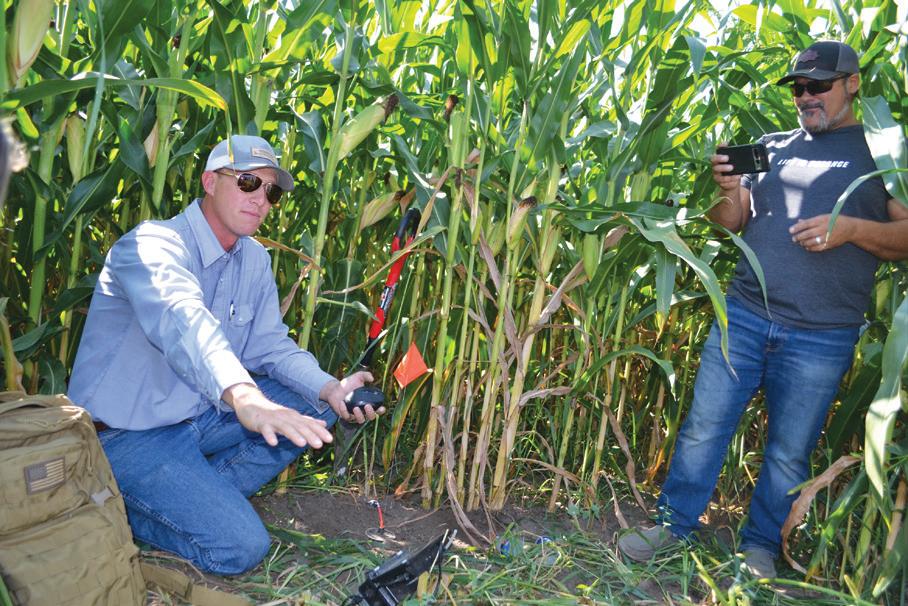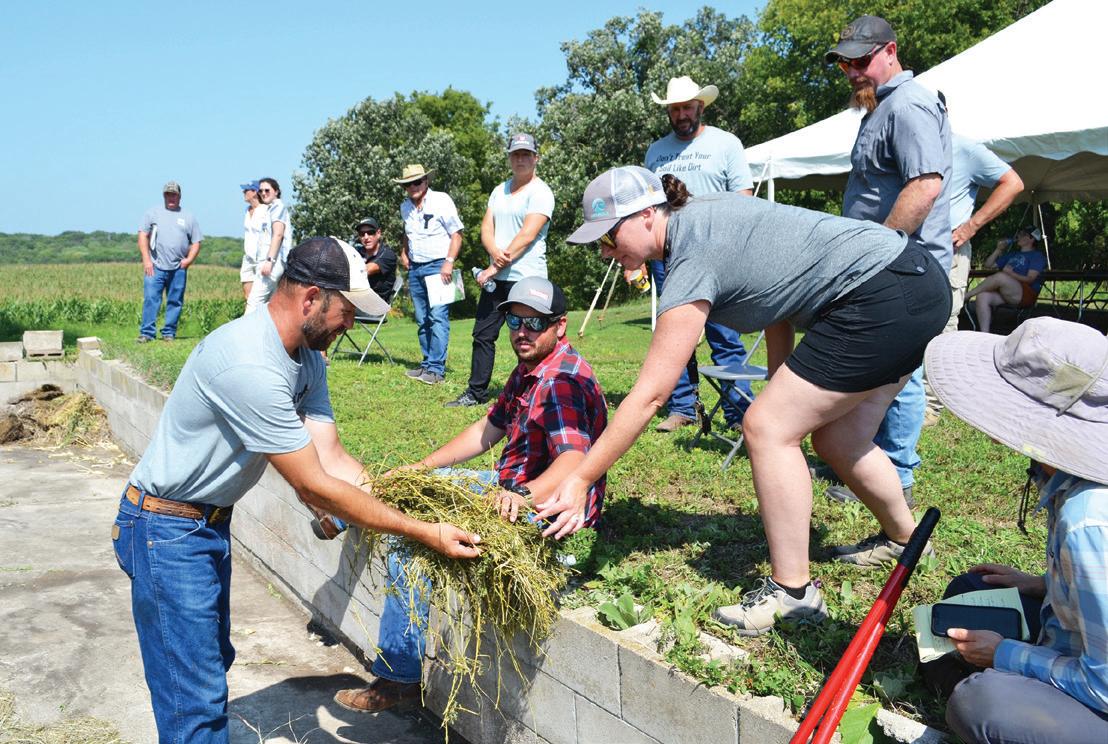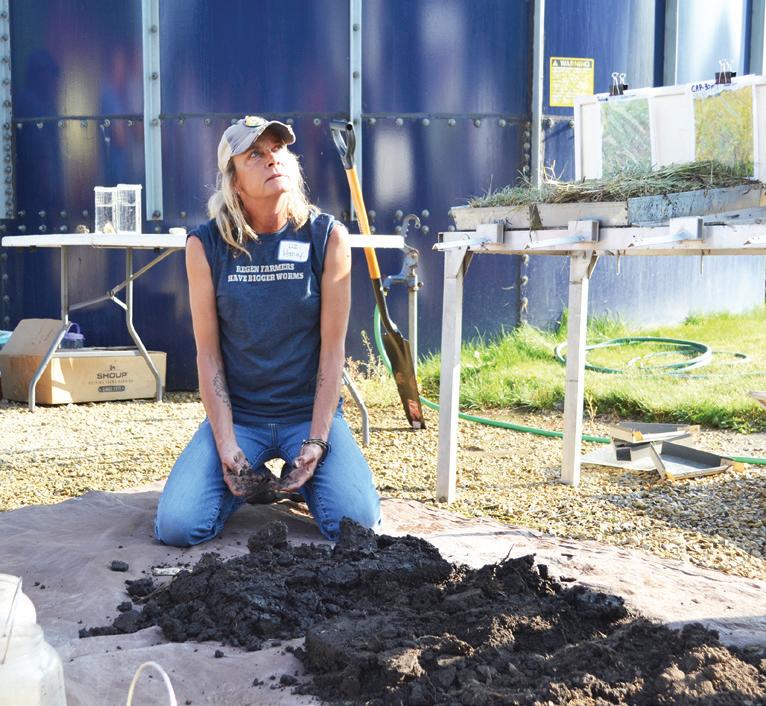
7 minute read
Soil Health A Long, Hot Summer
10 Farms Prepare for the Day When it Remembers to Rain
ample cover to shield the surface.
Advertisement
Short term compromises for the sake of long-term benefits have to be made all the time. That may mean violating a few soil health rules: killing a cover crop early, using intense tillage, spraying more pesticides than one would like. The goal should be to keep the big picture in mind and attempt to follow up a temporary negative practice with steps that build soil health in the long term.
By Brian DeVore
For many farmers, 2023 was one of those growing seasons where, as the old saying goes, “It seems like it forgot to rain.” In much of the Midwest, this was at least the second straight year of abnormally dry weather. According to the USDA, at one point topsoil moisture was “short” to “very short” across 79% of Iowa, 75% of Minnesota, 68% of Illinois, and 64% of Wisconsin. For a time, 94% of Minnesota was considered in a formal drought situation, with more than a quarter of the state in what meteorologists consider “extreme” or “exceptional” drought. There’s nothing like extreme weather to shake farmers’ confidence in the way they are managing their operations. So no wonder the dry, hot weather was topic number one during the numerous on-farm field days sponsored by the Land Stewardship Project and other organizations in 2023.
As one southeastern Minnesota crop and livestock farmer put it: “Water was the best fertilizer this year.”
On a hot (of course) day in early August, soil health expert David Kleinschmidt proved that statement true while kneeling in a cornfield on the Tom and Alma Cotter farm near Austin in southern Minnesota. While a crowd of field day participants watched, Kleinschmidt took a reading from a carbon dioxide probe that was sunk into the field’s soil. CO2 activity in soil is a key way to gauge how active the microbes are — the more microbial activity, the more biologically healthy the soil is. The reading was 1,400 parts per million of CO2 — the ambient air above the soil measured around 465 ppm. Then Kleinschmidt poured a bottle of water on the soil. The reading jumped to 1,600 ppm. Yes, water is the best fertilizer.
“The microbes are talking to each other,” said Kleinschmidt. “This soil is resilient.”
The lesson: someday it will remember to rain, and it when it does, it’s the farmer’s job to create the kind of soil environment that can take advantage of that moisture — an environment characterized by good aggregate structure, lots of biological activity, and
On the following pages are 10 examples from the 2023 field day season of what farmers are doing to create a welcoming home for that liquid fertility — whenever it arrives.
Flexible Farming Passing on Purity
Cover crops are a mainstay in building soil health, but during the Cotter field day, many farmers expressed concerns that during the drought of 2023 rye and other covers actually competed with cash crops for moisture, resulting in diminished corn and soybean yields. Kleinschmidt, who is the owner of the Illinois-based Progressive Agronomy Consulting company, says 2023 was a good reminder not to be a “rigid purist” and to keep all tools at your disposal when it comes to implementing soil health
The Cotter cornfield where the CO2 reading was taken is a prime example of such a balance being struck. Tom Cotter, who implements numerous soil-friendly practices on his crop and livestock farm, felt he had to use intense tillage to kill off a stand of alfalfa before planting the corn; otherwise, the alfalfa would evolve into a weed pest. But he followed that tillage with the planting of a cover crop. Despite the drought, the corn was thriving, and Kleinschmidt spaded up a soil sample that, although dry, showed signs of good aggregate structure. The spike in C02 activity indicated that this field still had microbial potential as well; a temporary setback in building soil health had been overcome with a longer-term strategy of keeping roots in the ground.
“Tom has done a fantastic job laying out those pros and cons and trying to stack more pros for every con,” said Kleinschmidt. u
Building Biology Great Expectations
Whentaking steps to build soil health, it’s easy to have high expectations for what’s possible. In fact, many pioneers in the field are seeing significant improvements in soil health within three to five years.
practices. Conventional wisdom says that soil benefits the most when cover crops like cereal rye are allowed to grow a foot or more before they’re terminated, but in a dry year that extra growth may simply be not worth the risk, said Kleinschmidt, adding, “We can have all the soil health in the world, but if we don’t raise a crop, what’s the value in that?”
So it’s not surprising that when Jordan, Minn., farmer Mike Seifert started on his soil health journey around 2018, he had high hopes when it came to the impact practices like no-till, cover cropping, and the integration of alfalfa and small grains into his corn-soybean rotation would have. And he did see an increase in aggregate structure, which has helped reduce erosion and increase his fields’ ability to manage moisture. He’s also been able to reduce what he spends on chemical inputs because of the practices he’s adopted. But during an August field day he and his wife, Dana, hosted, he conceded that he has been disappointed not to see the actual biology of his soil a lot further along by now. It turns out there’s a difference between constructing a solid house for that soil biome, and stocking the pantry with nutritious food.
Summer, see page 17…
…Summer, from page 16
Creating a healthy soil biome with a good balance of vibrant fungal activity can create fields that are more resilient in the long term, and which have the ability to cook up their own fertility and become resistant to weed and insect pests.
During the field day, Mike demonstrated how he’s spent the past two years trying to stock that pantry. The Seiferts have been experimenting with utilizing homegrown ingredients to build compost piles and then distilling them down to a liquid extract that are quite familiar with. The idea with compost extracts is to create a biological inoculum that sparks a kind of soil microbe chain reaction.

The farmer showed participants how to put together a compost stack made up of wood chips, corn husks, manure, and straw. After demonstrating how they had modified tillage equipment to apply the extract, Seifert led the way to a soybean field where he had side-by-side comparisons of what added biology can contribute to a crop. Part of the field had been treated with extract, while the other had not. The plants growing in the treated soil were noticeably more bushy and healthy looking, even on a day when the heat index was 116 Fahrenheit.
“That’s what you have a soil account for — so you can pull from it when times are rough,” said dairy farmer Nathan Vergin. (LSP Photo)
“We’re going to put as many species of life out in the field as possible and let nature select what it needs,” said Mike Seifert, shown here displaying some of the material he uses to make compost extract. (LSP Photo) is applied to their fields utilizing modified tillage equipment.
Mike made it clear that applying a compost extract to spark microbial life is different from making enough compost to cover an entire growing area, something gardeners
Seifert admitted the comparison didn’t constitute conclusive scientific results, but it gives him a sense that he’s learning ways to work with nature in a manner that feeds the soil, as well as his intellect.
“It’s like a shotgun approach — we’re going to put as many species of life out in the field as possible and let nature select what it needs,” said the farmer. “We have to find things that stimulate us mentally, because if we just keep doing the same things every year and hoping the situation will adjust to us, how likely are we to find success?” u
Measuring Microbes Taking a Soil Census
Building that biology does little good if farmers don’t have ways to accurately assess where the soil is at in terms of health and fertility. How do you figure out how far it is to your destination if you don’t know where you are located currently?
One way to gauge mileage in the soil health journey is to do an accurate soil test. Farmers and agronomists are no strangers to taking soil samples, sending them to a lab, and getting back recommendations for how much fertilizer to add. But Liz Haney says such tests don’t provide a full picture of the soil’s biological state, and thus can prompt farmers to overapply certain inputs, lowering a farm’s return on investment and harming the environment via runoff of excess nutrients. That’s why she and her husband, Rick Haney, have developed the Haney Test, a sampling method that attempts to measure the level of microbial respiration and other natural processes taking place in soil.

During a July field day at the Kevin Davis farm near Cannon Falls in southeastern Minnesota, the soil scientist explained that agronomists have often overlooked the role organic nitrogen can play in productive plant systems, and have thus emphasized adding inorganic, petroleum-based nitrogen, as well as other fertilizers, as much as possible.

But it’s become clear nitrogen that exists naturally in the soil can play a significant role in productive crop fields and pastures. While people gathered in Davis’s machine shed, Haney shared results of soil tests done on area farms and showed calculations of how much money could be saved on nitrogen fertilizer by tapping into the land’s natural ability to build fertility.
Her overall point: if we are going to “farm in nature’s image,” we need a soil test that also adheres to natural processes.
“We don’t want to dictate what’s happening,” said Haney. “We want nature and the soil to tell us what’s going on.” u
Banking Soil Health Rainy Day Fund
At one point during a September pasture walk hosted by Nathan and Amy Vergin, a local farmer pulled up the latest Minnesota drought monitor map on his smart phone. The Vergin farm, located just east of Rochester in southeastern Minnesota, was in the heart of an area marked by a lurid
Summer, see page 18…








